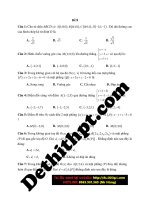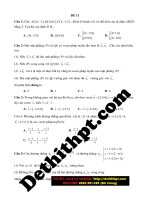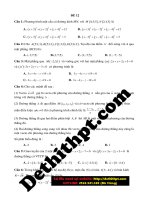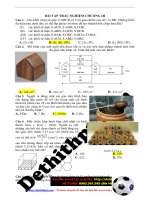Đề 27 image marked image marked
Bạn đang xem bản rút gọn của tài liệu. Xem và tải ngay bản đầy đủ của tài liệu tại đây (1.27 MB, 6 trang )
Exercise 27:
Read the following passage and mark the letter A, B, c or D to indicate the correct answer to each
of the questions.
Prehistoric mammoths have been preserved in the famous tar
pits of Rancho La Brea (Brea is the Spanish word for tar) in what is
now the heart of Los Angeles, California. These tar pits have been
known for centuries and were formerly mine for their natural
asphalt, a black or brown petroleum-like substance. Thousands of
tons were extracted before 1875, when it was first noticed that the
tar contained fossil remains. Major excavations were undertaken
that established the significance of this remarkable site. The tar pits
were found to contain the remains of scores of species of animals
from the last 30,000 years of the Ice Age.
Since then, over 100 tons of fossils, 1.5 million from vertebrates, 2.5 million from invertebrates, have
been recovered, often in densely concentrated tangled masses. The creatures found range from insects
and birds to giant ground sloths, but a total of 17 proboscideans (animals with a proboscis or long nose) including mastodons and Columbian mammoths - have been recovered, most of them from Pit 9, the
deepest bone-bearing deposit, which was excavated in 1914. Most of the fossils date to between 40,000
and 10,000 years ago.
Đăng ký file Word tại link sau
/>
The asphalt at La Brea seeps to the surface, especially in the summer, and forms shallow puddles that
would often have been concealed by leaves and dust. Unwary animals would become trapped on these
thin sheets of liquid asphalt, which are extremely sticky in warm weather. Stuck, the unfortunate beasts
would die of exhaustion and hunger or fall prey to predators that often also became stuck.
As the animals decayed, more scavengers would be attracted and caught in their turn. Carnivores
greatly outnumber herbivores in the collection: for every large herbivore, there is one saber-tooth cat, a
coyote, and four wolves. The fact that some bones are heavily weathered shows that some bodies
remained above the surface for weeks or months. Bacteria in the asphalt itself would have consumed
some of the tissues of other than bones, and the asphalt itself would dissolve what was left, at the same
time impregnating and beautifully preserving the saturated bones, rendering them dark brown and shiny.
QUESTIONS:
Question 1: What aspect of the La Brea tar pits does the passage
mainly discuss?
A. The amount of asphalt that was mine there
Trang 1
B. The chemical and biological interactions between asphalt and animals
C. The fossil remains that have been found there
D. Scientific methods of determining the age of tar pits
Question 2: In using the phrase "the heart of Los Angeles" in paragraph 1, the author is talking about
the city's ________.
A. beautiful design
B. central area
C. basic needs
D. supplies of natural asphalt
Question 3: The word "noticed" in paragraph 1 is closest in meaning to_________.
A. predicted
B. announced
C. corrected
D. observed
Question 4: The word "tangled" in paragraph 2 is closest in meaning to ________.
A. buried beneath
B. twisted together
C. quickly formed
D. easily dated
Question 5: The word "them" in paragraph 2 refers to________.
A. insects
B. birds
C. sloths
D. proboscideans
Question 6: How many proboscideans have been found at the La Brea tar pits?
A. 9
B. 17
C. 1.5 million
D. 2.5 million
Question 7: The word "concealed" in paragraph 3 is closest in meaning to _____.
A. highlighted
B. covered
C. transformed
D. contaminated
Question 8: The word "scavengers" in paragraph 4 is closest in meaning to ____.
A. the animals that are dead
B. the animals that eat meat
C. the animals that eat feed on lead or decaying matter
D. substances added to a mixture to remove or inactivate impurities
Trang 2
Question 9: Why does the author mention animals such as coyotes and wolves in paragraph 4?
A. To give examples of animals that are classified as carnivores.
B. To specify the animals found least commonly at La Brea.
C. To argue that these animals were especially likely to avoid extinction.
D. To define the term "scavengers".
GIẢI CHI TIẾT
Question 1: What aspect of the La Brea pits does the passage mainly discuss?
A. The amount of asphalt that was mined there.
B. The chemical and biological interactions between asphalt and animals.
C. The fossil remains that have been found there.
D. Scientific methods of determining the age of tar pits.
Dịch nghĩa: Khía cạnh nào của La Brea bài viết tập trung thảo tuận?
A. Lượng asphalt được khai thác ở đây.
B. Sự tương tác hóa học và sinh học giữa asphalt và động vật.
C. Những hóa thạch được tìm ra ở đây.
D. Những biện pháp khoa học để xác định tuổi của những hố hắc ín.
Giải thích: Đọc bài ta thấy chủ yếu thông tin xoay quanh những hóa thạch được tìm thấy ở La Brea.
Hơn nữa ta có câu mở đầu bài viết "Prehistoric mammoths have been preserved in the famous tar pits of
Rancho La Brea..."-" Những con voi ma mút cổ đại đã được bảo quản trong những hố hắc ín nổi tiếng ở
Rancho la Brea..."
Question 2: In using the phrase "the heart of Los Angeles" in paragraph 1, the author is talking about
the city's ____________.
A. beautiful design
B. central area
C. basic needs
D. supply of natural asphalt
Dịch nghĩa: Khi dùng cụm từ "the heart of Los Angeles", tác giả đang nói về cái gì của thành phố?____.
A. thiết kế đẹp mắt
B. khu vực trung tâm
B. những nhu cầu thiết yếu
D. nguồn asphalt tự nhiên
Giải thích: "Prehistoric mammoths have been preserved in the famous tar pits of Rancho La Brea in what
is now the heart of Los Angeles, California"-"Những con voi ma mút cổ đại đã được bảo quản trong
những hố hắc ín nổi tiếng ở Rancho la Brea (Brea là từ tiếng Tây Ban Nha chỉ hắc ín) ở nơi mà bây giờ là
trái tim của Los Angeles, California."
Ta thấy trước the heart of Los Angeles có in what is now... -"ở nơi mà bây giờ..."vậy sau đó phải là một
danh từ chỉ một địa điểm.
Vậy trong ngữ cảnh này, "the heart of Los Angeles" nghĩa là chỉ khi vực trung tâm thành phố Los
Angeles.
Trang 3
Question 3: The word "noticed" in paragraph 1 is closest in meaning to______.
A. predicted
B. announced
C. corrected
D. observed
Dịch nghĩa: Từ "noticed" gần nghĩa nhất với __________.
A. dự đoán
B. tuyên bố
C. sửa chữa
D. quan sát
Giải thích: Ta có (to) notice = (to) observe: quan sát, nhận thấy rằng
Question 4: The word "tangled" in paragraph 2 is closest in meaning to _____.
A. buried beneath
B. twisted together
C. quickly formed
D. easily dated
Dịch nghĩa: Từ "tangled"gần nghĩa nhất với ___________.
A. bị chôn bên dưới
B. bị xoắn vào với nhau
C. được tạo thành dễ dàng
D. dễ dàng định xác tuổi tác
Giải thích: ta có be tangled = be twisted together: xoắn vào, quận vào nhau
Question 5: The word "them" in paragraph 2 refers to ________.
A. insects
B. birds
c. sloths
D. proboscideans
Dịch nghĩa: Từ "them" ở đoạn văn số 2 nói đến _______.
A côn trùng
B. chim
c. con lười
D. thú có vòi
Giải thích: ta thấy câu: "The creatures found range from insects and birds to giant sloths, but a total of 17
proboscideans (animals with a proboscis or a long nose) - including mastodons and Columbian
mammoths - have been recovered,
most of them from pit 9..."-"Những sinh vật được tìm thấy trải rộng từ côn trùng và chim cho đến những
con lười đất khổng lồ, nhưng tổng cộng 17 con vật có vòi (động vật có vòi hoặc 1 cái mũi dài) - bao gồm
những con voi khổng lồ và loài ma mút Colombia đã được tìm thấy, hầu hết từ hố số 9..."
Như vậy từ"them"-"chúng" ở đây là để chỉ những con thú có vòi.
Question 6: How many proboscideans have been found at the La Brea tar pits?
A. 9
B. 17
c. 1.5 million
D. 2.5 million
Dịch nghĩa: Có bao nhiêu con vật có vòi được tìm thấy ở hố hắc ín của La Brea?
A.9
B.17
c. 1.5 triệu
D. 2.5 triệu
Giải thích: "but a total of 17 proboscideans (animals with a proboscis or a long nose) - including
mastodons and Columbian mammoths - have been recovered,..."-"nhưng tổng cộng 17 con vật có vòi
(động vật có vòi hoặc 1 cái mũi dài) - bao gồm những con voi khổng lồ và loài ma mút Colombia đã được
tìm thấy..."
Question 7: The word "concealed" in paragraph 3 is closest in meaning to______.
A. hightlighted
B. covered
C. transformed
D. contaminated
Dịch nghĩa: Từ "concealed" ở đoạn văn số 3 ________.
Trang 4
A. được làm nổi bật
B. bị bao phủ
C. bị biến đổi
D. bị ô nhiễm
Giải thích: ta có (to) be concealed = (to) be covered: bị che phủ, che giấu...
Question 8: The word "scavenger" in paragraph 4 is closest in meaning to _____.
A. the animals that are dead
B. the animals that eat meat
C. the animal that feed on dead or decaying matter
D. substance added to a mixture to remove of inactivate impurities
Dịch nghĩa: Từ "scavenger" ở đoạn 4 gần nghĩa nhất với ________________.
A. những con vật đã chết
B. những con vật ăn thịt
C. những con vật ăn xác chết hoặc đang thối rữa
D. chất để thêm vào một hỗn hợp để loại bỏ cặn bẩn
Giải thích: Ta có Scavenger: thú ăn xác thối, những con vật ăn xác chết hoặc đang thối rữa. As the
animals decayed, more scavengers would be attracted and caught in their turn.
Question 9: Why does the author mention animals such as coyotes and wolves in paragraph 4?
A. To give examples OS animals that are classified as carnivores
B. To specify the animals found least commonly at La Brea
C. To argue that these animals were especially likely to avoid extinction
D. To define them as "scavengers"
Dịch nghĩa: Tại sao tác giả đề cập những con thú như chó lớn và chó sói ở đoạn 4?
A. Để cho ví dụ về những con vật được xếp vào thú ăn thịt
B. Để chỉ ra những con vật được tìm thấy ít nhất ở La Brea
C. Để tranh luận rằng những con vật này đặc biệt tránh tuyệt chủng
D. Để định nghĩa chúng như thú ăn xác thối
Giải thích: Ta có câu trước:"Carnivores greatly outnumber herbivore in the collection: for every large
herbivore there is one saber-tooth cat, a coyote, and four wolves"-"Những loài động vật ăn thịt có số
lượng nhiều hơn rất nhiều động vật ăn cỏ trong bộ sưu tập: cho mỗi con thú ăn cỏ có 1 con mèo răng
kiếm, một con chó lớn và 4 con chó sói”.
DỊCH BÀI
Những con voi ma mút cổ đại đã được bảo quản trong những hố hắc ín nổi tiếng ở Rancho Ia Brea
(Brea là từ tiếng Tâỵ Ban Nha chỉ hắc ín) - trái tim của Los Angeles, California ngày naỵ. Những hố hắc
ín này đã được biết đến hàng thế kỉ và từng được khai thác cho nguồn asphalt tự nhiên của chúng, một
chất màu đen hoặc nâu giống như dầu mỏ. Hàng ngàn tấn đã được điều chế trước 1875, khi lần đầu tiên
người ta biết đến rằng trong hắc ín có chứa hóa thạch. Những vụ khai quật lớn đã được tiến hành, tạo nên
Trang 5
điểm nổi bật cho khu vực này. Những hố hắc ín đã được tìm thấy có chứa những phần còn lại của rất
nhiều loài động vật từ 30 nghìn năm trước kỉ băng hà.
Từ sau đó, hơn 100 tấn hóa thạch, 1,5 từ động vật có xương sống, 2,5 từ động vật không xương sống,
đã được tìm ra, thường là ở trong những khối đặc hỗn độn. Những sinh vật được tìm thấy trải rộng từ côn
trùng và chim cho đến những con lười đất khổng lồ, nhưng tổng cộng 17 con vật có vòi (động vật có vòi
hoặc 1 cái mũi dài) - bao gồm những con voi khổng lồ và loài ma mút Colombia đã được tìm thấy, hầu
hết từ hố số 9, quặng chứa hóa thạch sâu nhất, được khai quật vào năm 1914. Hẩu hết hóa thạch có từ 40
ngàn đến 10 ngàn năm tuổi.
Asphalt ở La Brea thấm lên mặt đất, đặc biệt là vào mùa hè, và tạo nên những vũng lầy bị lá cây và
bụi che khuất. Những con vật không biết điều này sẽ bị sa xuống và mắc kẹt trong những lớp mỏng
asphalt lỏng, một thứ rất dính trong thời tiết ấm. Khi bị mắc kẹt, những con vật không may mắn này sẽ
chết vì kiệt sức và đói khát, trở thành con mồi cho những kẻ săn mồi mà thường cũng sẽ trở thành nạn
nhân. Khi những con vật này thối rữa, rất nhiều thú ăn xác thối sẽ bị thu hút đến đây và tiếp tục lần lượt bị
mắc kẹt.
Những loài động vật ăn thịt có số lượng nhiều hơn rất nhiều động vật ăn cỏ trong bộ sưu tập: cho mỗi
con thú ăn cỏ có 1 con mèo răng kiếm, một con chó lớn
và 4 con chó sói.
Sự thật là một số xương bị phơi nắng cho thấy một
vài xác chết đã nằm lại trên mặt đất hàng tuần hoặc hàng
tháng.
Vi khuẩn trong asphalt có thể đã tiêu thụ những tế
bào khác ngoài xương, và asphalt sẽ hòa tan phần còn lại,
cùng lúc nó cũng xâm nhập và bảo tồn hoàn hảo những
cái xương đã bị thấm vào, trả lại chúng màu nâu đậm và
bóng bẩy.
Trang 6









